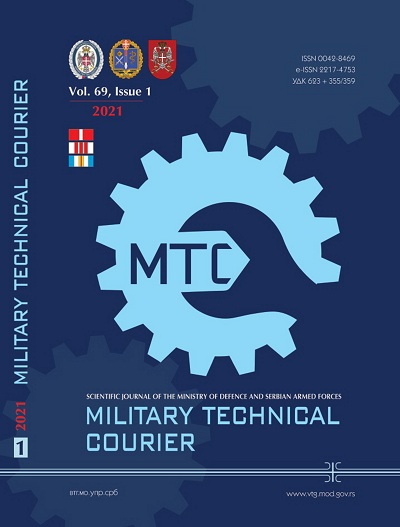Identification of soldiers and weapons in military armory based on comparison image processing and RFID tag
Abstract
Introduction/purpose: The process of issuing and retrieving weapons in the military should be fast enough and should provide immediate availability of accurate information on the status of weapons.
Methods: This paper deals with the problem of digitizing the recording of issuing and returning weapons through the use of modern Edge computing technology. The problem is presented through two approaches. The first approach is based on the application of machine learning algorithms for recognizing the serial number of a weapon based on the camera image, while the second approach concerns the application of RFID technology. User authentication is based on the application of biometrics.
Results: The results obtained from testing the architecture for identifying weapons using a camera indicate that such an architecture is not suitable for identifying weapons. A weapon identification solution using RFID technology overcomes the problems of the previously mentioned solution. However, RFID technology requires additional modifications regarding the implementation of tags on or into weapons so that readings can be made.
Conclusion: The implemented weapon identification solution based on RFID technology and a user identification solution with biometric authentication enables easy and reliable identification, speed of issuing and retrieval of weapons, network relieving, and real-time monitoring of the weapon status.
References
Chattaraj, A., Bansal, S. & Chandra, A. 2009. An intelligent traffic control system using RFID. IEEE Potentials, 28(3), pp.40-43. Available at: https://doi.org/10.1109/MPOT.2009.932094.
-Electronicsnotes. 2020. RFID Frequency Bands & Spectrum [online]. Available at: https://www.electronics-notes.com/articles/connectivity/rfid-radio-frequency-identification/frequency-bands-spectrum.php/ [Accessed: 20 August 2020].
-Freetts.Sourceforge. 2017. FreeTTS 1.2.3 - A speech synthesizer written entirely in the JavaTM programming language [online]. Available at: https://freetts.sourceforge.io/ [Accessed: 20 January 2020].
Hanmandlu, N., Mittal, N. & Vijay, R. 2017. A robust Finger Knuckle Print Authentication using topothesy and Fractal dimension. Defence Science Journal. 67(1), pp.66-73. Available at: https://doi.org/10.14429/dsj.1.9003.
Kour, J., Hanmandlu, M. & Ansari, A.Q. 2016. Biometrics in cyber Security. Defence Science Journal, 66(6), pp.600-604. Available at: https://doi.org/10.14429/dsj.66.10800.
Lien, T. 2011. Automatic identification technology tracking weapons and ammunition for the Norwegian Armed Forces. MA thesis. Monterey, California: Naval postgraduate school [online]. Available at: https://calhoun.nps.edu/handle/10945/5715 [Accessed: 20 August 2020].
Maltoni, D., Maio, D., Jain, A.K. & Prabhakar, S. 2009. Handbook of Fingerprint Recognition. Springer Nature Switzerland AG. Available at: https://doi.org/10.1007/978-1-84882-254-2. ISBN: 978-1-84882-254-2.
Nicholls, R. 2017. Implanting Military RFID: Rights and Wrongs. IEEE Technology and Society Magazine, 36(1), pp.48-51. Available at: https://doi.org/10.1109/MTS.2017.2654288.
Nogueira, R.F., de Alencar Lotufo, R. & Campos Machado, R. 2016. Fingerprint Liveness Detection using Convolutional Neural Networks. IEEE Transactions on Information Forensics and Security, 11(6), pp.1206-1213. Available at: https://doi.org/10.1109/TIFS.2016.2520880.
Pawar, N., Shaikh, Z., Shinde, P. & Warke, J.P. 2019. Image to Text Conversion Using Tesseract. International Research Journal of Engineering and Technology (IRJET), 6(2), pp.516-519 [online]. Available at: https://www.irjet.net/archives/V6/i2/IRJET-V6I299.pdf [Accessed: 20 August 2020].
Prajapati, S., Joshi, S., Maharjan, A. & Balami, B. 2018. Evaluating Performance of Nepali Script OCR using Tesseract and Artificial Neural Network. In: IEEE 3rd International Conference on Computing, Communication and Security (ICCCS), Kathmandu, Nepal, pp.104-107, October 25-27. Available at: https://doi.org/10.1109/CCCS.2018.8586808.
-Pyimagesearch. 2018. OpenCV OCR and text recognition with Tesseract [online]. Available at: https://www.pyimagesearch.com/2018/09/17/opencv-ocr-and-text-recognition-with-tesseract/ [Accessed: 20 August 2020].
Reale, A. 2017. A guide to Edge IoT analytics [online]. Available at: https://www.ibm.com/blogs/internet-of-things/Edge-iot-analytics/ [Accessed: 20 August 2020].
Saleous, H., Shaikh, A., Gupta, R. & Sagahyroon, A. 2016. Read2Me: A cloud-based reading aid for the visually impaired. In: International Conference on Industrial Informatics and Computer Systems (CIICS), Sharjah, UAE, pp.1-6, March 13-15. Available at: https://doi.org/10.1109/ICCSII.2016.7462446.
-SimpleSoftware. 2020. OCR Guide [online]. Available at: https://www.simpleocr.com/ocr-guide/ [Accessed: 20 August 2020].
-SkyRFID Inc. 2020. RFID Tag Maximum Read Distance [online]. Available at: http://skyrfid.com/RFID_Tag_Read_Ranges.php [Accessed: 20 January 2020].
Thakkar, D. 2020. Fingerprint Image Compression: Know Why It Matters [online]. Available at: https://www.bayometric.com/fingerprint-image-compression/ [Accessed: 20 August 2020].
Proposed Creative Commons Copyright Notices
Proposed Policy for Military Technical Courier (Journals That Offer Open Access)
Authors who publish with this journal agree to the following terms:
Authors retain copyright and grant the journal right of first publication with the work simultaneously licensed under a Creative Commons Attribution License that allows others to share the work with an acknowledgement of the work's authorship and initial publication in this journal.
- Authors are able to enter into separate, additional contractual arrangements for the non-exclusive distribution of the journal's published version of the work (e.g., post it to an institutional repository or publish it in a book), with an acknowledgement of its initial publication in this journal.
- Authors are permitted and encouraged to post their work online (e.g., in institutional repositories or on their website) prior to and during the submission process, as it can lead to productive exchanges, as well as earlier and greater citation of published work (See The Effect of Open Access).

